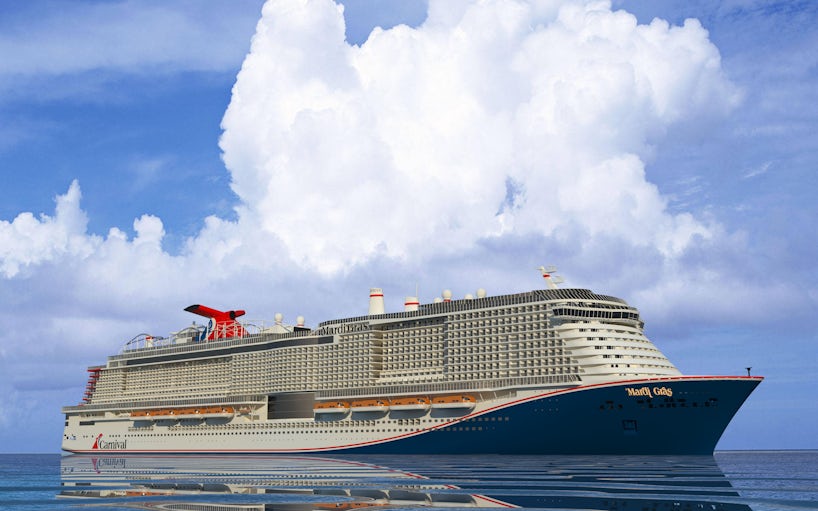
What Is Sustainable Cruising, and Why Should I Care?



The buzz from the first full Seatrade Cruise Global cruise conference to be held in Miami since the start of the pandemic can be summed up in one word: sustainability.
At the world's largest cruise industry conference, cruise lines, executives and manufacturers touted sustainability as the watchword of the industry. Attendees were told, time and again, that the one thing passengers cared about -- indeed, perhaps the only thing on their minds -- was sustainability.

"Sustainability is the greatest issue we face," Cruise Lines International Association Global Chairman and MSC Cruises Executive Chairman Pierfrancesco Vago (pictured above) said at the opening keynote speech.
Although many lines have committed to net-zero carbon emissions by 2050, it's the steps that the lines will take to get there that are more relevant, for example, according to Vago: by 2027, 66% of cruise ships will use shoreside power, which constitutes more than half the global fleet.
But what does sustainability actually mean, in the context of cruising? What is sustainable cruising, and why should you care?
Cruise Critic took a deep-dive into the subject at the annual conference in April 2022 and came away with some impressions that might both interest -- and surprise -- cruisers.
New Technologies Make Ships More Eco-Friendly Than Ever

Perhaps the most obvious goal for the cruise industry is to reduce its reliance on fossil fuels, a process that, like much of the mechanized world, is neither simple nor straightforward.
Indeed, cruise lines have already been making strides to make their ships more eco-friendly. Many parts of the world require lines to use cleaner-burning marine gas oil instead of traditional heavy bunker fuel, and several lines have begun the switch to liquefied natural gas, which they say reduces emissions further still.
While new cruise ships, like Carnival's Mardi Gras (pictured above), P&O Cruises' Iona and next year's new ship class from Royal Caribbean, Icon of the Seas, use LNG, ship operators like Hurtigruten and Silversea are taking a different tack, refitting existing vessels with hybrid technology -- we're talking new engines, catalytic reduction modules, new green hydrogen fuel cells and even dead fish as a fuel source; or in the casi of Silversea, pioneering "multi-hybrid" technology (see below).
The conversion process, undertaken in conjunction with Kongsberg Maritime, is one of the largest environmental upgrade programs ever undertaken in Europe, according to the Norway-based company.
Hurtigruten Group CEO Daniel Skjeldam told Cruise Critic he believes ports should consider turning away vessels that do not reach environmental standards.
"The regions and the ports need to be a lot tougher when it comes to setting demands for cruise lines," he said. "They need to insist on standards when it comes to fuel type, use, size and whether the ship is equipped with shore power technology."
Ship design is also key to increasing efficiences, as Captain Henrik Loft Sorenson, who helms Royal Caribbean's newest ship, Wonder of the Seas explained onboard. Using an Air Lubrication System (ALS), bubbles are created below the hull of the ship to allow it to glide through the water more easily.

Should you sail on a ship that has hybrid technology or reliance on fuels other than heavy bunker oil? It's always at the discretion of the cruiser. However, at this stage, it is worth noting that a lot of the real hybrid technology is being done on smaller expedition vessels that visit some of the most remote parts of the world. Smaller ships also have an advantage in that battery options are possible in powering these ships for the short term, and wind power is also possible -- think of the sailing ships from Windstar or Star Clippers, for example, for those looking to reduce their carbon footprint.
Further muddying the waters is that LNG has been called a "transition" option by many in the industry as it looks for better ways to fuel its vessels. Viking, for example, has said it will run its new cruise ships using hydrogen, which Chairman Torstein Hagen says is a cleaner option than LNG. (Viking did not attend the Seatrade conference.) Carnival Corporation CEO Arnold Donald even noted at the State of the Industry panel that some great breakthroughs had recently been made using "fusion" (e.g. nuclear).
Beyond power, lines have been leading the way when it comes to recycling, elimination of single use plastics (remember all those plastic straws onboard ships? -- gone) and reducing food waste -- one of the big complaints levelled at lines.
Carnival Corporation for example has just completed the installation of nearly 600 food waste biodigesters across its entire global fleet. The technology naturally breaks down food waste using a mix of natural aerobic digestion and microorganisms.
Shore Power Is Expanding Its Footprint

One of the simplest ways cruise lines can cut down on emissions is to plug into shoreside power, allowing vessels to power down their fuel-hungry diesel engines that are needed for both marine (propulsion) and hotel (lights, air conditioning) operations.
Ports like Vancouver, Canada, have been equipped with shore power hookups for more than a decade, while others -- like busy Florida turnaround mainstay Port Everglades -- are just now getting into the shore power game.
It's a similar story with the lines -- CLIA notes that 174 vessels are equipped with shoreside power capabilities.
"Many cruise ships are also ready to utilize shore power, which limits emissions in the communities we visit," said Pierfrancesco Vago "We look forward to utilizing shoreside power as more cruise ports develop their infrastructure."
"We're ready to plug in," he added. "The cruise industry is ready to plug in."
Trouble is, not every port has shoreside power -- and finding out which ones do is not something the average consumer has access to, making this a technology that is powerful on a real-world level but difficult to assess from a customer standpoint.
The Scandinavian countries, led by Norway, are leading the way, with at least seven ports along the Norwegian coastline being fitted with shore power over the next few years.
"The cruise lines are moving faster than the shoreside," Cruise Copenhagen's Claus Bodker said.
Further complicating matters: The investment from ports isn't cheap or easy, and destinations that are unable to support shoreside power could suffer.
Terminals And Private Islands Are Also Going Green

Sustainability does not end at shoreside technology -- terminals themselves are becoming sustainable.
The first "green" building was the Broadway Cruise Terminal (pictured above) at Port of San Diego for Holland America Line, designed by one of the leading architectural firms and pioneers in sustainable technology, Bermello Ajamil & Partners (BA).
BA has gone on to design a terminal at Port of Miami for Norwegian Cruise Line (2021), to Port of Galveston's Royal Caribbean terminal currently under construction.
BA's CEO Luis de Carvalho said: "The cruise and maritime industry and associated sectors are to a certain extent leading the way in sustainability and environment protection initiatives which are also being driven by government guidelines and regulations, and at the same time public awareness on these matters has also been growing in the last years."

Beyond green cruise terminals, one of the biggest success stories of sustainability is MSC Cruises private island, Ocean Cay Marine Reserve.
BA transformed what was a polluted, industrial island into a 100+ acre oasis cleaning up on its 46 acres of beaches and creating an 84-square mile marine reserve.
Sustainability at Sea: More Than Just Clean Energy
What exactly constitutes sustainability is harder to pin down once the major topics -- fuel, energy efficiency, waste management -- have been discussed.
One topic that was popular pre-COVID -- and continues to be -- is the dispersing of passengers. Sustainable cruising could mean not flooding ports with thousands of passengers per day, instead limiting the number of passengers that call on a particular place at once.
Expedition cruise lines have been doing this for years. Areas like the Galapagos, Antarctica and the Arctic place strict limits on how many passengers can go ashore in a given day, how many vessels can call and how big these ships can be.
That trend has expanded to other ports like Key West, which passed legislation limiting the size and passenger capacity of vessels calling on the popular Florida Keys port. That debate is still ongoing -- the port wants small, luxury ships to visit, but those vessels don't carry the passenger demographic that tends to be interested in going to Key West, for the most part.
And this month Palma de Mallorca passed legislation that will limit the number of cruise ships calling in at the port to three, from 2026.

It's a similar story on the other side of the world, in Tahiti, which imposes strict limits on ship size in order to preserve the pristine environment.
However, the islands are also mindful that cruise tourism can be used as a force for good -- for example, in the development of more remote islands.
To that end, the islands have developed a 2030 plan which will see two of the more remote South Sea islands be developed -- gradually -- to become turnaround ports: Rangiroa and Nuku Hiva.
In Nuku Hiva the aim is to extend the airport to allow small- and mid-sized planes to land, and this will "facilitate the development of turnaround ports in these communities," according to Jean-Marc Mocellin, Director General of Tahiti Tourisme, and bring in much-needed tourist dollars.
The key, as ever, is sustainable development and the cumulative daily amount is capped at 1,200 in Bora Bora and the cruise terminal in Papeete can accommodate ships of up to 2,500 passengers.

The debate about size -- and overtourism as a larger issue -- has been at the front and center of the cruise debate surrounding Venice, Italy, which welcomes the same number of tourists in a day in peak season (300,000) as Tahiti does in a year.
Size limits means cruise ships can no longer sail into the city, with Royal Caribbean committing to developing a new cruise terminal in Ravenna, which lies about 88 miles to the south.
Other cruise lines are also planning new terminals in popular ports to aid in the dispersing of passengers. In Alaska for example, Norwegian Cruise Line has invested heavily in a new cruise terminal north of Ketchikan at Ward Cove, and it is planning to utilize a new pier location in Juneau in the next few years.
Cruise lines adjusting port times and schedules, as well as exploring new ports of call, will continue to be one of the more visible aspects of sustainability in the cruise industry.
Are Cruisers Ready for Sustainable Options?

Despite the prevalence of sustainability as a topic at Seatrade Cruise Global, the question remains whether cruisers are ready for sustainable options in the first place -- and whether they will go out of their way to pay for more eco-friendly experiences versus others.
Several executives told Cruise Critic that, by and large, most buy-in from passengers is a challenge.
"I don’t think our guests are ready yet," said Gerald Mosslinger, Seabourn's senior vice presicent of guest operations.
Silversea's Chief Marketing Officer, Barbara Muckermann told Cruise Critic it comes down to educating guests on why they should care.
Silversea's new class of ship, Silver Nova, is bigger than the rest of the fleet, not because the company wanted to put more passengers onboard but rather to house all the new technology.
Silver Nova, which debuts in summer 2023, will be the world's first "multihybrid" ship, running on a combination of LNG and battery power.
"Exactly like a hybrid car," CEO Roberto Martinoli said.
The technology being pioneered will allow the ship to be completely self-powered in port, so it won't even need shoreside power:
"This is very exciting technology," Martinoli said. "It means completely zero carbon emissions when the ship is in port."
But why should passengers care?
"Because it will be silent," Muckermann explained. Thus, it will dock silently at a port, with no rumblings or noise, and cut through Arctic waters on battery power, meaning less disturbance -- and more chances to see -- marine life.
Cruise Critic Data Shows Sustainability Does Matter to Cruisers
Cruise Critic's own survey data reveals some interesting metrics. A survey conducted of over 800 members in February 2021 revealed that 77% say environmentally friendly cruise line policies and protocols are important to them. Over a third of respondents said they have become more aware of cruise lines' sustainability initiatives in recent years, but a full 20% say it is not something they pay attention to at all.
The initiatives rated most highly among Cruise Critic members polled were wastewater treatment and management systems (67 percent rated it as "Very Important"); onboard recycling programs (61% consider it "Very Important"); and the elimination of single-use plastics, with 45% saying that aspect was "Very Important."
As Luis de Carvalho says, much of the change in the industry will depend on consumer choices. Many of us know it is better for the environment -- and our wallets -- if we drive an electric or hybrid car, yet many of us do not for a variety of reasons. Cost, reliability, logistics and the sheer distance achieved by gasoline cars tend to keep many of us beholden to fossil fuels.
That, too, is slowly changing. Fully electric cars are more commonplace, and environmental sustainability is top-of-mind for many people.
Once consumer habits evolve, change will likely come quickly to the cruise industry. The good news is, that alignment is already starting to happen, as cruise lines act on a number of fronts -- from the elimination of plastic straws, to hybrid engines and propulsion systems that will make the ships of tomorrow greener and quieter than ever before.